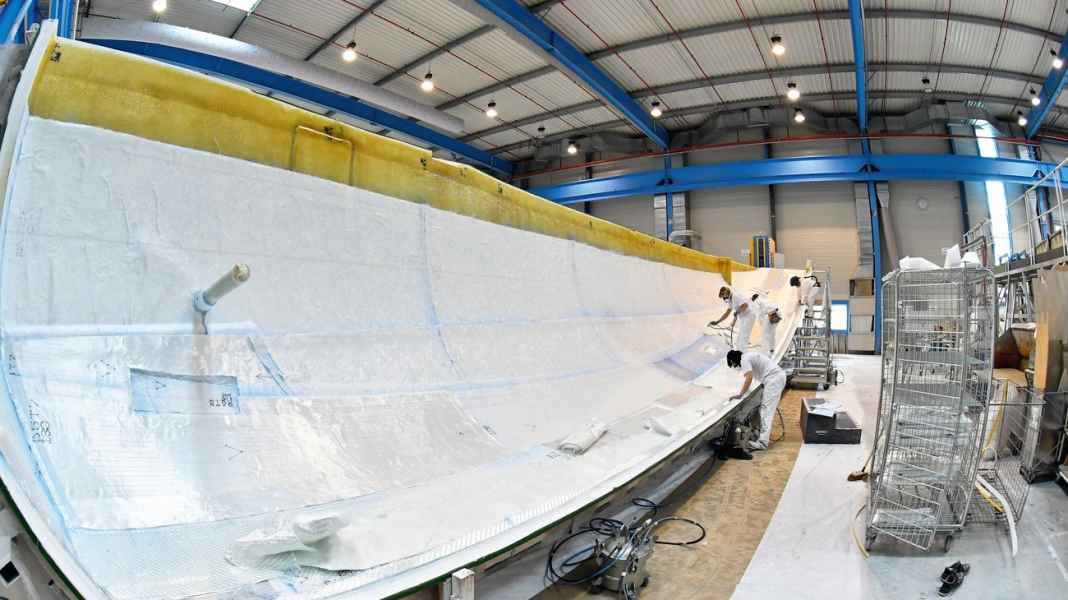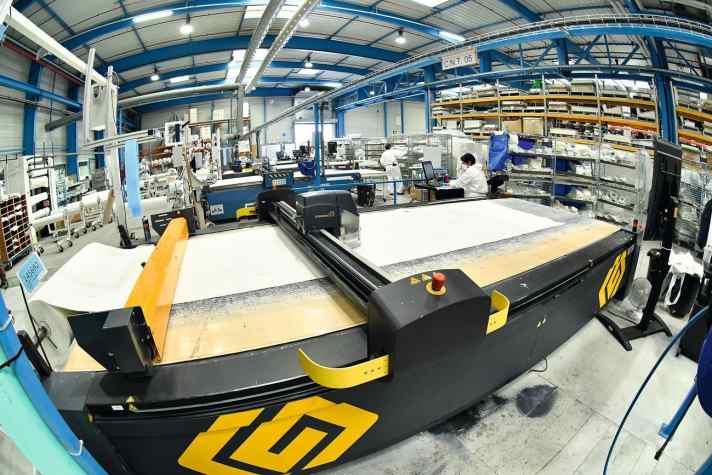
Europe's boat industry is booming like it hasn't been for years. In addition to small and medium-sized companies, which make up around 90 % of the industry, the French Beneteau Group represents one of the leading global players: the family-run shipyard has developed its current market position in boat building through unique expertise and a good feel for the market.
With ten world-famous brands such as Beneteau, Jeannau, Prestige, Monte Carlo Yachts, Glastron, Four Winns and Lagoon, the group now covers the entire portfolio - from sailing yachts to motorboats, which account for 56% of total sales, and from monohulls to catamarans.
BOOTE had the unique opportunity to take a look behind the scenes at the production facilities and exchange ideas with the experts at the company headquarters in Saint-Gilles-Croix-de-Vie, a small coastal town in the Vendée, 80 kilometres south of Nantes.
More than 200 models from 4.5 m to over 30 m in length make customers' dreams come true and fulfil all boating needs. Around 9500 boats - including 28 new models - were sold in the 2016/17 financial year via a total of 1000 points of sale (mainly dedicated dealers) worldwide.

The Boatbuilding segment accounts for 85% of Group sales (total sales of € 1.2 billion in the 2016/17 financial year and thus a growth rate of 11.2% most recently). These figures are backed by industrial and logistical agility, as well as sophisticated and established partnerships with suppliers for technical and interior fittings and for all production systems in use.
A premise that applies equally to the development and production of boats and yachts as well as holiday homes - the second strong pillar of the Group. Beneteau values its 6,000 employees (7,000 in total) at its 19 production sites in boatbuilding alone as a decisive potential:
"Their unique technical expertise and craftsmanship can be seen in our products." emphasises Mirna Cieniewicz. "It is their passion that unleashes our creative capacity and energy. This enables us to maximise the satisfaction of our customers and offer them the best possible service, wherever they may be in the world,emphasises the Director of Communications.
Insight into the organisation's recruitment, employee integration and training programmes speaks volumes about the company's policy to promote committed human resources.

The Group builds boats for a total of ten brands - from motorboats to sailing yachts - at 15 sites in France, two in Italy and one in Poland. In addition, the Group has two production sites in Michigan and South Carolina in North America, where 25% of turnover has been generated to date with potential for further growth.
1910: The world's first motorised fishing boat sets sail. From the founding days under Benjamin Bénéteau in 1884 to the first motorised sardine fishing boat built by him in 1910 and the creation of the universal digital interface "Ship Control", which was launched in 2017, the company's history has been characterised by innovation.
"All of the Group's brands are guided by our commitment to innovate and improve, anticipate expectations, develop the most innovative materials and develop high-performance products at a lower cost."explains Mathieu Herson from Purchasing.
Craftsmanship and technology
In addition to this credo, which was recently reinforced by the global strategic plan "Transform to Perform" in 2015, Beneteau launched a programme to drastically improve workflow, availability and throughput in the cutting of fibreglass materials and the production of all boat hulls.
Today, the construction of boats and motor yachts has reached a standard that seemed impossible just a few years ago. This is due to fibre-reinforced composite materials, which have long since made their triumphant advance in boat building.
Four Z1 cutting systems from Gerber Technology, the world's leading supplier of automation systems, handle the cutting of a total of 40 different types of composite material in three shifts a day, five days a week, at the Beneteau site.
"Thanks to the continuous cutting capability and high cutting speed, the Gerber cutting systems have doubled our productivity."Landry Chauvière is delighted.
Process optimisation challenge: The cutting times for all parts of a boat hull can vary between 20 minutes and 20 hours, depending on the size of the boat.
"By implementing the Jet-Pen solution for labelling the cut parts and display ID(entification), our technology partner enabled us to improve our picking and sorting process." adds the manager responsible for technical coordination and quality.
This resulted in a reorganisation of the development and production processes, with all necessary adjustments clearly defined in advance.
Innovative spirit: The challenge of saving energy
The promotion of innovation, environmental protection, the preservation of the corporate spirit and the sustainable further development of expertise - all this is also covered by the commitment of the company's own foundation, which has launched 21 projects and initiated a number of pioneering competitions since its establishment in 2005.
In the motorboat segment in particular, the foundation now supports initiatives to promote energy savings and protect the marine environment. And this is also how today's challenges for contemporary maritime products and applications are met, whether for leisure or professional use.
The foundation has already achieved outstanding results. These include the development of hybrid propulsion for motorboats, the use of the pultrusion process for lighter boat hulls and the electrolysis-based treatment of all types of waste water - to name just a few examples.

In 2017, the French authorities also decided to reduce the exposure limit value for styrene, which is widely used in boatbuilding but is controversial, by more than half. One way of meeting this new requirement would have been to significantly increase ventilation, which in turn would have doubled energy consumption.
However, this option was not in line with the company's environmental commitment and would have meant a step backwards on the road to certification in accordance with international environmental and energy management standards ISO 14001 and 50001.
Instead, an action plan for styrene was immediately introduced, covering several key areas in terms of raw materials and processes used.
Once again our colleague from Beneteau Communications, Mirna Cieniewicz:"While it is up to each company to define its level of commitment, we decided a long time ago to simply eliminate the words "impossible" and "never" from our vocabulary."
The key to Groupe Beneteau's success: highly automated production
Composite materials, as used for hulls, decks and other plastic parts on all Beneteau brands (including Jeanneau, Lagoon, MCY - Monte Carlo Yachts, CNB, Prestige and the US brands Four Winns and Glastron acquired in 2014), meet the highest standards in terms of surface quality, weather resistance, long-term protection against salt and fresh water as well as osmosis, fading and colour change.
This is partly the result of progress in the development of new and affordable automation systems. In addition to plastics production, the new production processes in the Beneteau shipyards also extend to engine and drive installation, electrics and the interior.

